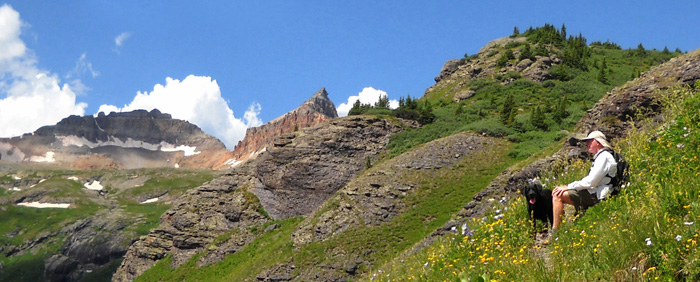Compared to Huntsville State Park's 210-acre Lake Raven, which is also
dammed, Lake Livingston looks like an ocean from the shoreline! It's
pretty big.
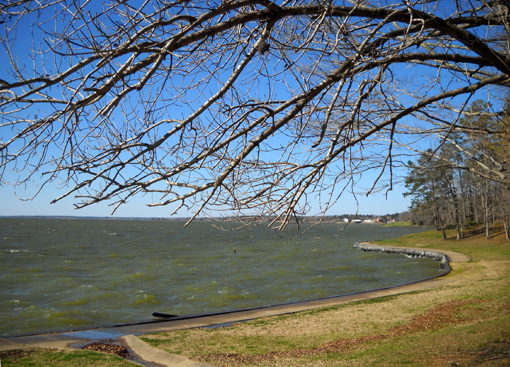
This relatively small state
park about 70 miles north of Houston contains
only 635 acres of land but has quite a bit of scenic shoreline to draw visitors
who like to fish, participate in any number of water sports, or just relax and
enjoy the view. We were one of the latter. I imagine it's a popular place for
residents from the metro area and nearby towns to cool down in the hot, humid
summer weather.
Although some days in February are sunny and warm, winter is not the time to
enjoy Lake Livingston State Park at its finest. Winter is the rainy season and
freezing temperatures are not out of the norm.
Unfortunately, our first
trip to the park (in mid-February) was more cold, wet, and gray
than sunny and warm. That's not the park's fault, but our poor timing.
Fortunately, the two or three sunny days we got shed a much better "light" on
the park so we didn't come away with totally negative feelings about it.
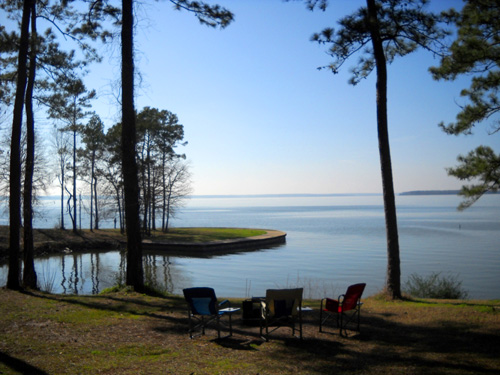
The weather wasn't any better at Huntsville State Park about fifty miles to
the west. The big difference is that the terrain is hillier and the soil drains much better at Huntsville.
A park maintenance guy told us Lake Livingston got an unusual amount of rain in
January and early February and the ground was just too saturated to continue to
absorb it.
We were very tired of muddy trails and standing water in the campground
by the time we left Lake Livingston and returned to Huntsville.
I explained in the
last entry how we ended up camping at Lake
Livingston SP for a week in the middle of a five-week stay at Huntsville. We don't totally regret our decision. We got to explore part of another
Texas state park (the parts that weren't too muddy) -- and we gained a
new appreciation for Huntsville SP!
There is no video on the park website as there is for some of the other
Texas state parks but you can see a map of the park at this
link. It shows the campgrounds and trails,
too.
LAKE LOGISTICS
Lake Livingston was formed in 1968 when an earthen dam was built on the
Trinity River to flood a fertile valley in southeastern Texas to form a large
reservoir. The 710-mile river enters the lake from the northwest and flows out the
southeastern end to Trinity Bay, part of Galveston Bay, and on to the Gulf of
Mexico.
We drove near the dam on our way back to Huntsville. Wow -- the river
below the dam (in the foreground of the photo below) looked quite flooded!
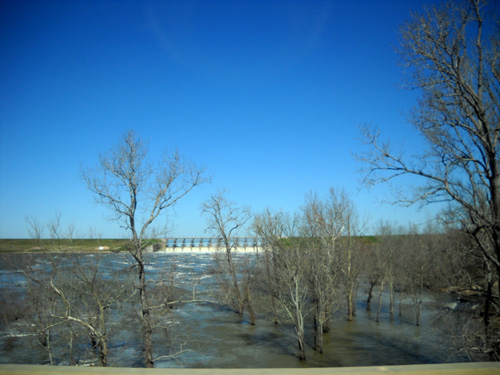
The land for the state park was acquired by warranty deed and from private owners in 1971 and
opened to the public in 1977, according to the Texas Parks & Wildlife
Department's (TPWD) web
page for Lake Livingston State Park. The park
is located on the southeastern shore of the lake near the ghost town of Swartwout, which had a steamboat landing on the
Trinity River in the mid-1800s.
Now the closest town to the park is Livingston,
about seven miles NE of the park entrance. It is described as a trade center for the
prosperous lumber and agricultural businesses in the Trinity River Valley.
Livingston is also home to the
Escapees, a club that is popular with
full-time RVers, many of whom use Texas as their legal residence. There
are numerous private RV parks in the area around Livingston and the lake to
accommodate these folks when they return to their "home base," as well as
visitors who enjoy fishing and boating on the lake.
Livingston was convenient for some but not all of the services we wanted
while we were at the park. It has a super WalMart and a Lowe's store, which is
pretty good for a town of fewer than 5,000 year-long residents. Jim was happy to find
a What-a-Burger franchise (sometimes he's just gotta have a burger!). There is
no YMCA or Sam's Club anywhere near and none of the three laundromats were as nice
as the one we use in Huntsville. It was fine for a week, though.
CAMPING OPTIONS
Lake Livingston SP has a wide range of campsites, including ten screened
shelters next to the lake (they look more like cabins),
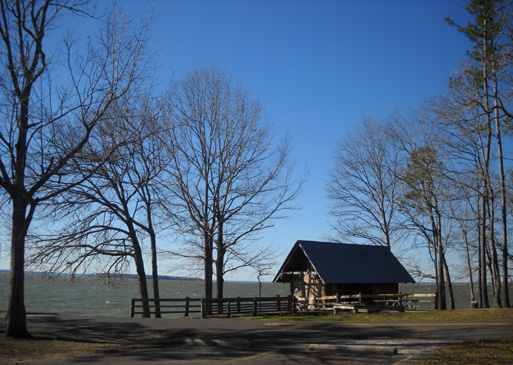
group tent and trailer sites, multi-use campsites with hookups, and an
overflow area near the horse stable at the far end of the narrow park.
When we made reservations the week before our visit, all but one site in the
four RV campgrounds was already booked for the President's Day holiday weekend.
Our reservation was for the Hercules Club Loop, which has smaller sites than
the Youpon, Red Oak, and Piney Shores loops. Hercules is used more for tents
and pop-up trailers.
Since we arrived on a rainy Monday afternoon, we got our choice of sites in
Hercules, which was a good thing considering it was about the only site we could
fit in!
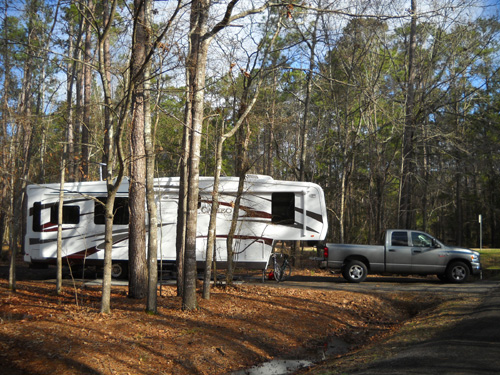
Besides the small sites, the main thing that struck us as we drove through
the campground was all the water standing around. It was a swamp!
This entire park is much flatter than Huntsville and its soil was completely
waterlogged by the time we got there. Except for the concrete "driveway" for
our camper, the rest of our site was unusable the entire week we were there
(below). So were most of the other sites in this loop.
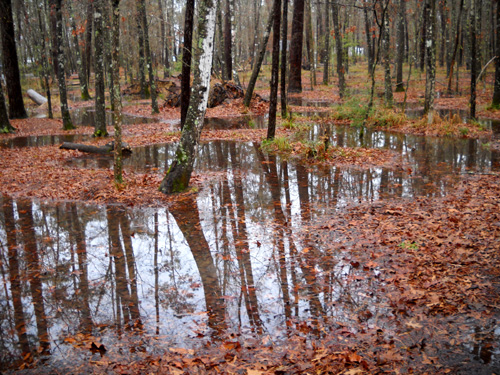
Thank goodness our camper pad was paved. We would have headed back to
Huntsville if it was all mud and puddles, too!
The other three loops, which have sites that are better suited for travel
trailers, 5th-wheels, and motor homes, were just about as swampy as Hercules. Other than
that, we probably would have been happier in one of those.
Only about 20 of the 147 RV sites in the park have a glimpse of the lake. At
Huntsville almost every site has a scenic lake view.
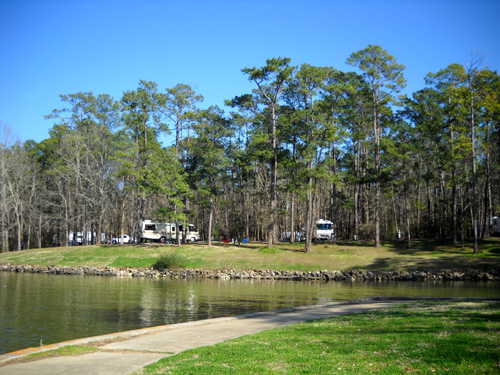
As it turned out, neither Lake Livingston nor Huntsville state parks were
anywhere near filled during the holiday weekend because of the mostly cold, wet
weather preceding it. We probably could have moved the Cameo to another loop at Lake
Livingston on Friday afternoon when it was obvious there would be empty spots
all weekend, but it just wasn't worth the effort it would take (in the rain) to move the
camper for three nights. The other sites were waterlogged, too.
We checked out the overflow campground, which was the only other option we
had when we arrived, but the sites are very close together there (next photo). That's a good
isolated
area for group camping, however.
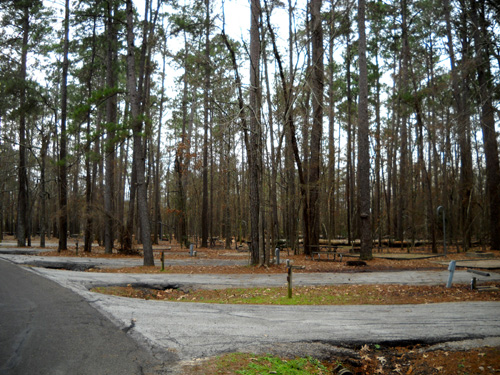
We were surprised that TV reception was so poor at Lake Livingston;
we don't have satellite service and cable wasn't available (it's rare to find
cable at a state park). We weren't able to
get NBC or ABC at either Huntsville or Lake Livingston. The closest CBS
affiliate is Bryan-College Station, which is west of Huntsville. We could get
CBS off and on at Huntsville, but not at Lake Livingston, which is another 50 miles farther from
Bryan-College Station. I don't know why larger Houston stations don't serve
either Huntsville or Lake Livingston state parks.
We had about the same level of Verizon service (1-2 bars) at Lake Livingston
as at Huntsville. Our slow broadband internet connection with the cell phone
left a lot to be desired in both parks, however. It's much faster when we have
3-4 bars. At Huntsville SP Jim often
drove less than a mile from our campsite to one of the WiFi connections in the
park when he needed a high-speed connection on his laptop. We didn't have that
option at Lake Livingston.
FEES
Check the park web site for current
fees before you
visit. While we were there, campsites with water and electricity were
$15/night. Those in the Piney Shores and Red Oak CGs with sewers were
$18/night. A few "premium" sites in Piney Shores with full hookups and a lake
view were $25/night:
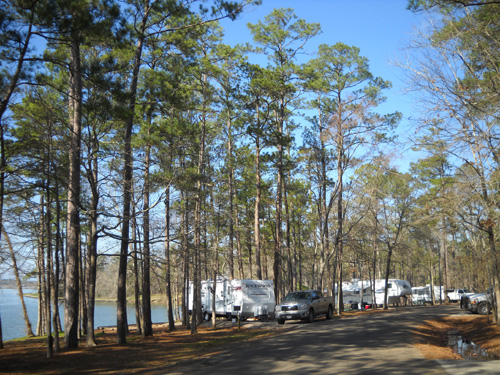
When the sun finally came out on Saturday, the Piney
Shores sites by the lake were taken.
Lake Livingston doesn't have a weekly rate in the winter like Huntsville
does.
There are nice bathrooms with showers in each camping loop and one dump
station for RVers who stay in sites without sewers.
The park entry fee at Lake Livingston was only $3/day, the lowest price in
the Texas State Park system. Entry was free with our parks pass and we were
able to use a half-price coupon for one day of our camping fees.
ACTIVITIES IN THE PARK
Lake Livingston is very popular with anglers. The Trinity River white bass
run in January reportedly attracts thousands of visitors. According to the
state park
guide, catfish are plentiful and flatheads as
large as 114 pounds have been caught there. That's close to the
world record of 123 pounds for a flathead catfish. Fisher-folks can also find
crappies and perch in this lake.
The park offers boat ramps, fishing piers, fish-cleaning shelters, and a
seasonal (March-October) marina and store (below) with bait shop and gas.
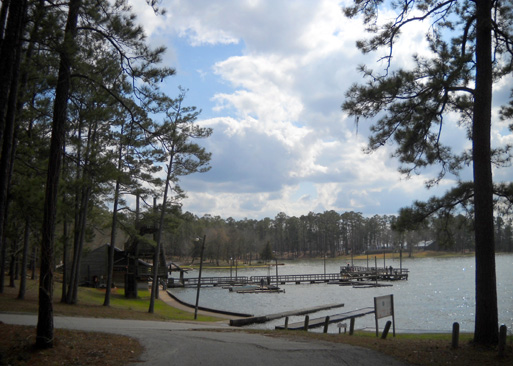
Boaters and paddlers also enjoy the large expanse of water at Lake
Livingston.
There is a small beach area for swimming in the lake. From Memorial Day to
Labor Day, visitors may swim in a pool that overlooks the lake. The pool is
behind this bath house and amphitheater:
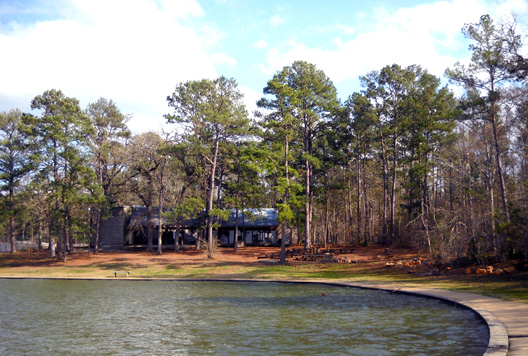
That's lake water in the foreground, above. The concrete "sea wall" and
walkway almost make it look like a pool.
Equestrians can ride several miles of trails at Lake Livingston but they
have to rent the horses at the stable; they cannot bring in their own horses
like they can in some other Texas state parks. The week we were there, the
trails weren't in any better shape for riding horses than for hiking and
running, but I saw at least one group go out for a ride on
Saturday:
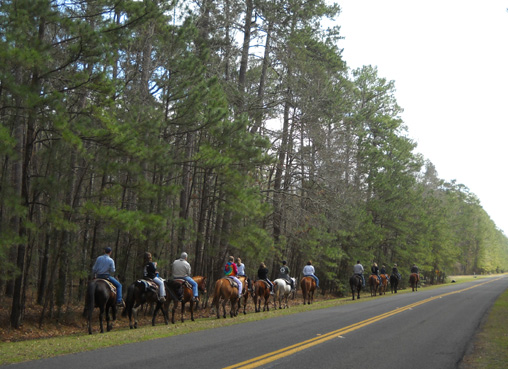
The riders were just leaving the stables and turned off onto muddy trails
just up the road.
Lake Livingston has some nice picnic areas in grassy areas above the lake or
in the pine and hardwood forest that covers much of the park. There are also paved and dirt paths along part of the lake shore.
I've shown several of those in pictures above.
Wooden bridges cross some of the coves and feeder streams:
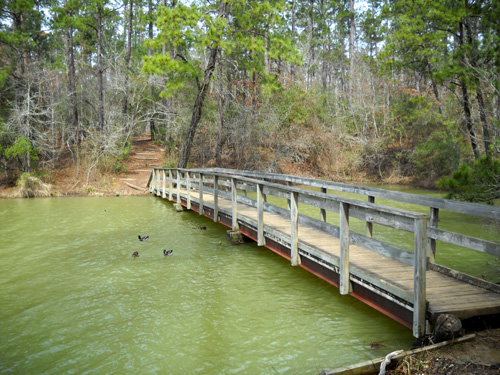
I was surprised how slanted and rickety one of them was, wondering when
someone would fall in the water and sue the park for negligence!
One of the bridges on the most remote trail loop was washed out and hasn't been
replaced:
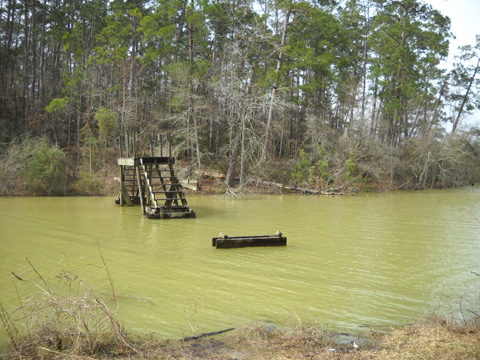
Various other things I observed on walks and rides around the park indicate a
lot more time and money are needed there to bring this park up to speed with
the other ones we've visited. It really needs some volunteer help.
CONTINUED SOUTHERN DISCOMFORT
Even on sunny days there was quite a bit of wind when we walked along the
lake -- enough to cause whitecaps on the waves. That would feel good in
the summertime but it made for some brisk Febu-ugly walks.
The average temperature for this area is about 65 F. in mid-February. Only
two of seven days we were at Lake Livingston got into the 60s. The rest topped
out in the 40s or low 50s.
Most days rained while we were there. One day we had sleet. Huntsville and
Bryan-College Station, which are about the same latitude, got snow that day.
Lake Livingston SP apparently enjoys some "lake effect" temperature moderation
since it's on the eastern side of the water.
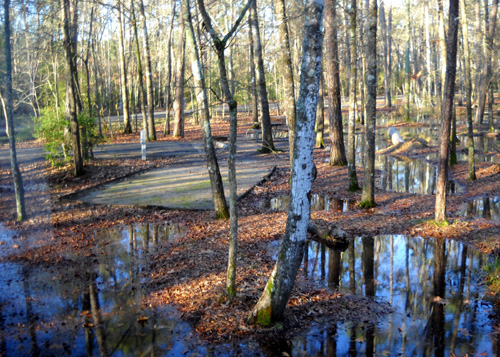
The campsite next to us was still this
wet when a couple and four 10- to 12-year-old girls
pitched tents here on the weekend! The girls
appeared to have fun anyway.
As much as we mumbled to ourselves about the cold, wet weather, we still had
it much better than the East and Southeast -- that's where our crummy
weather system headed next, and apparently got much worse. We knew better than
to complain to friends and relatives in areas that were hard hit!
According to one evening news report we watched, that huge winter storm left snow in parts of every state except Hawaii
-- and another one was right on its heels!
The
Philadelphia, Washington, DC, and Baltimore areas got four to five feet of snow
that week. The federal government was basically shut down for several days. Roanoke got
slammed with 15-18" of snow again. Our Ohio relatives fared better with "only" 8-12
inches of
the white stuff. Dallas, TX set a record with 12" of snow. Parts of the southern
U.S. that haven't had snow in two decades got up to 5". Freeze warnings
extended through Florida . . .
What a winter
it was in some parts of the country! Ironically, friends up in Maine had
a much milder season than average. That helped our friend
Eric
maintain his peak-bagging quest of New England mountains all winter.
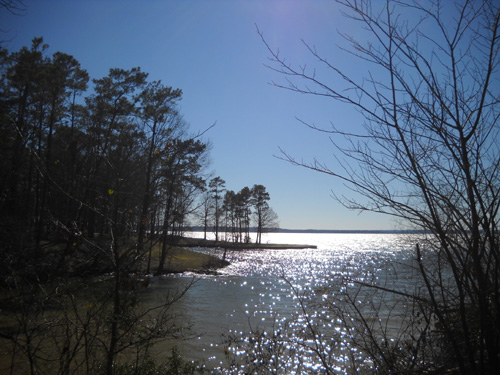
Yeah, it's chilly but hey! The sun is out!!
Our spirits were finally lifted during the Presi-Day weekend when the sun
came out on Saturday afternoon (above) and Sunday morning. We enjoyed seeing
everything in a different light, so to speak.
At that point, sunshine was more important to us than warmth.
We enjoyed Lake Livingston so much more when it was sunny, although we still
couldn't use most of the dirt trail system. Our campground loop was full of Boy
Scouts and families with kids; they had to be real careful where they
pitched their tents but the kids enjoyed splashing around in the puddles when
the adults weren't looking.
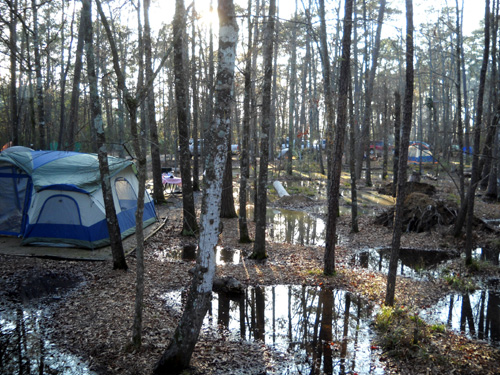
About a third of the RV sites remained empty in the other loops.
By Sunday afternoon most folks in our campground left as the clouds and wind
increased. The other campgrounds were only about half full despite the holiday
on Monday.
TRAILS AT LAKE LIVINGSTON SP
There are about seven miles of trails in Lake Livingston State Park. Because
of all the standing water and mud from previous rainfall and all the additional
rain that fell while we were there, we were able to effectively use only about
three miles of the trail system and even that was an effort. The trails
are reportedly much drier in the summer.
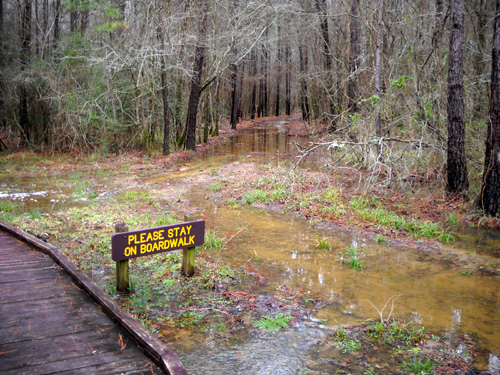
Gladly!! The trail is a creek right
now.
Cody thoroughly enjoyed all the standing water, of course. No one has more
fun in puddles, creeks, and lakes than he does! He's pure Lab, built for
paddling.
One day I tried to take his example and just walk through all the puddles on
one of the trail loops but it got to be too much work and not enough fun.
If it was just the water, it would have been fun. The mud underneath it
sucked the energy out of me. I ended the walk on the grassy shoulder along the
park road, which you can barely see in the next picture:
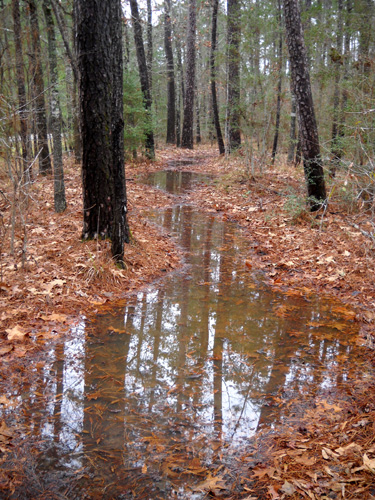
During our visit both Jim and I ended up walking/running more on pavement
than on the trails, and I cycled only on paved roads. Parts of the path next to the
lake are paved
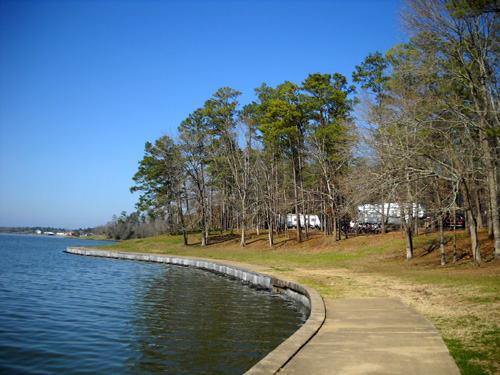
and there are about three miles of roads through and between the
campgrounds, picnic areas, boat ramps, and park entrance.
My favorite "trail" was more boardwalk than trail:
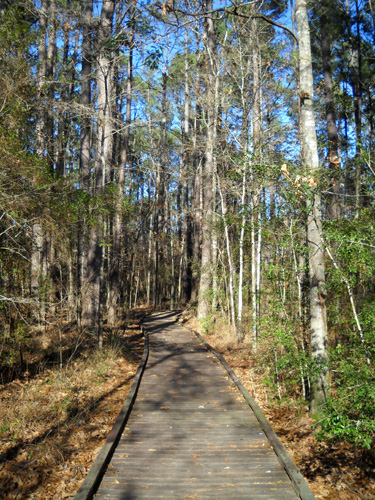
The Pineywoods Nature Trail is a one-mile wheelchair-accessible loop that
winds through
wetlands, woodlands, and a field. This is the entrance to the trail:
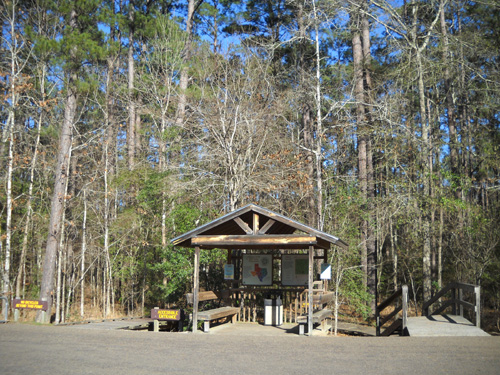
There are offshoots to a butterfly garden and frog and duck ponds.
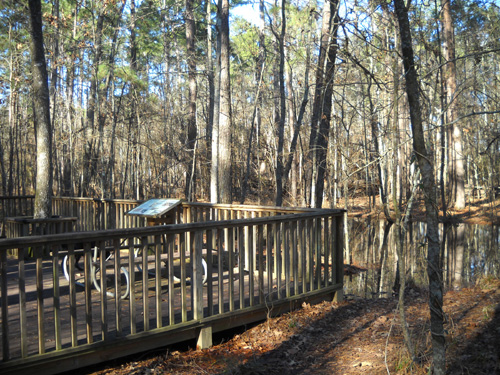
Frog pond, with an exhibit about
amphibians and reptiles
Jim even did repeat loops on the boardwalks one day, prepping for the
one-mile loop course at the Delano 12-Hour Run in Alabama in mid-March (which
he ended up not running because we decided to stay all month at Brazos Bend
SP.)
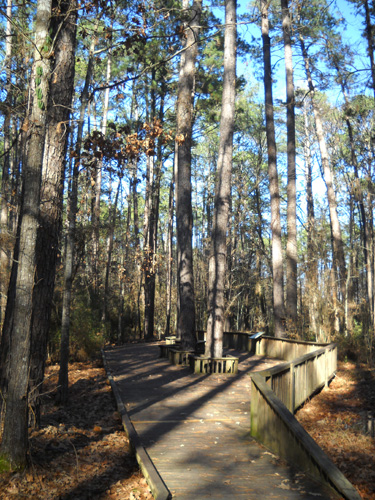
There were several exhibits (one is above) along the nature trail describing the ecosystem --
the trees and other plants in the combination wetland/woodlands, birds,
butterflies, mammals, amphibians, reptiles, and the disappearance of wetlands
across the country.
There was no mention of alligators, although the swampy areas looked like a
good place for them to live:
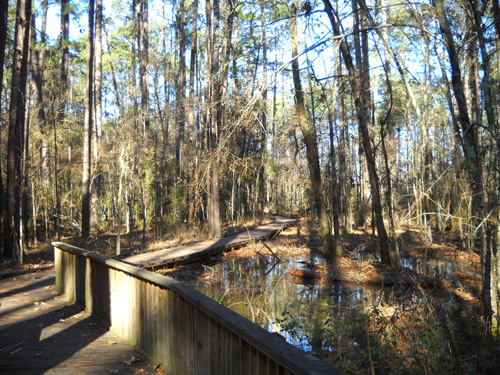
Several multi-use dirt trails intersect with this loop but all were
impassable due to standing water and mud.
NATURAL FEATURES
Much of this park is heavily wooded, which makes it a fairly cool place to
camp in the summer. Loblolly pines and water oak dominate this section of the Pineywoods
Region.
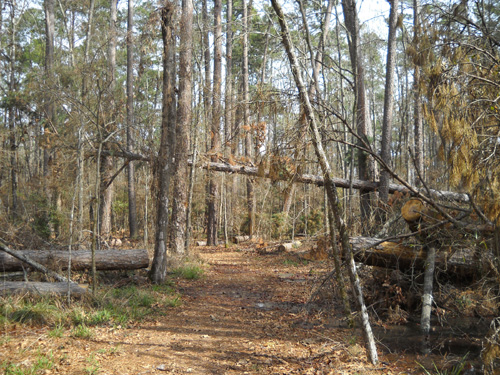
I was surprised at the large number of huge trees, mostly shallow-rooted
pines, that were uprooted throughout the park (above). Most were cleared from the
trails we ran but some places still looked like quite a mess. I never did ask if it was
from Hurricane Ike or the inordinate amount of rain they had this winter. The
needles were still green on some of the trees, indicating they came down more
recently than Ike.
We also saw many 10-16" diameter tree trunks in piles, stacks of limbs here
and there, and large limbs used as rip-rap to prevent erosion in the coves
along the lake.
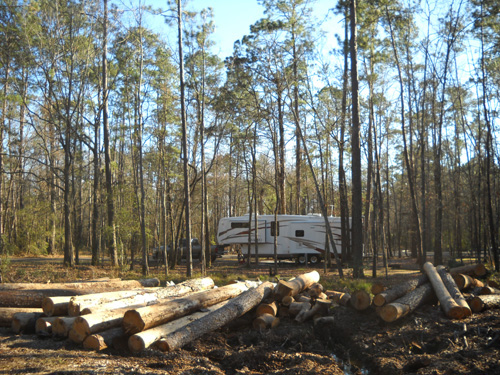
These tree trunks were in our "side
yard."
There were also a fair number of trees lying in the water along the
banks right where they had fallen, their roots washed clean.
Even though the lake is dammed and the water level can be adjusted, it
appeared to be pretty high. We're guessing there's been enough flooding
downstream recently that engineers have to be careful about releasing more
through the dam.
The wildlife is similar to that at Huntsville SP.
I saw very few mammals or birds out and about at this park, probably because of the
foul weather. I saw ducks (below) but no shore birds like herons and egrets, which live
at nearby Huntsville SP.
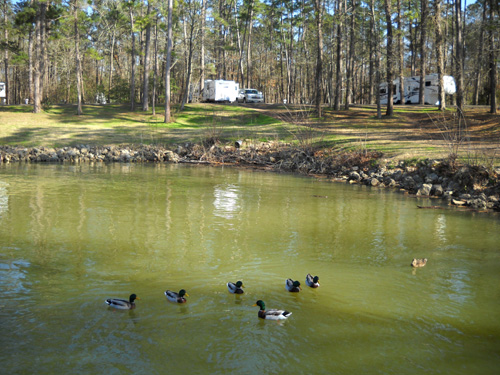
Too foul even for fowl? They were probably down closer to the Gulf.
MOVING ON
We were quite happy on President's Day to pack up after lunch and head back to Huntsville State Park for
another 2+
weeks. In retrospect we should have taken the risk of staying there,
considering the lousy weather and the likelihood of people canceling their
reservations. But we didn't know that at the time and didn't want to have to
spend the holiday weekend at WalMart!
Next entry: finding humor in the strangest places (yes, it's
related to Texas)
Happy trails,
Sue
"Runtrails & Company" - Sue Norwood, Jim O'Neil,
and Cody the Ultra Lab
Previous
Next
© 2010 Sue Norwood and Jim O'Neil
